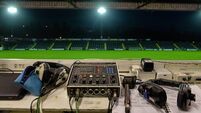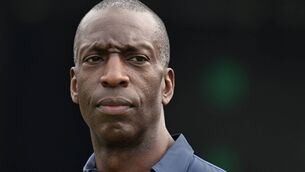In a League of its own

And, having already done the same for the FAI board and SSE Airtricity League clubs on preceding nights — as the climax to months of research before the writing up of his admirably comprehensive 75-page report — it was hardly a surprise that he was beginning to look distinctly weary as a relentlessly critical tone dominated the intensive 50 minutes of meeja questioning which followed his presentation.
And I can’t absolve myself. I may have been one of those who was interviewed by Conroy in the course of his research — though, disappointingly, my suggestion that clubs be obliged, under a stringent new licensing directive, to provide half-time tapas to the press doesn’t seem to have made the final cut — but, on Tuesday, I found myself asking him at one point if the lure of England’s Premier League was now so irresisitible and virtually all encompassing for Irish football fans that, no matter what radical revamping or tinkering around the edges might take place in the domestic game, the current dubious health of the League of Ireland might actually be as good and as bad as it’s ever going to get.
As you might expect, Conroy wasn’t having any such defeatist talk.
“I don’t believe that for a moment,” he replied. “All the sex and rock and roll that goes with the Premier League is a reality. But if we have planned visits to schools on a regular basis, do I believe there is potential to increase attendances? Unquestionably, because I don’t believe the maximum is being achieved.”
On the face of it, school visits versus sex and rock ‘n’ roll might seem like a bit of a no-contest but, the more I think about it, the more I feel it gets close to providing a possible solution to the most fundamental challenge facing the domestic game: how to get more bums on seats.
There are, of course, numerous issues which touch on the core question and most of them are addressed in the report, from stadium infrastructure to the very structure of the league itself.
Addressed but not answered, however, for the report’s remit was to take the pulse of the game in 2015 not perform actual surgery, and even though Conroy does finish up by writing a prescription in the form of 18 recommendations, we’re none the wiser at this early stage as to whether all, some or any will be implemented, never mind whether all, some or any will help provide the much-desired cure.
After so many years of seeing the League of Ireland relegated to the role of sideshow by the majority of those who profess a love of football in this country, it’s hard to shake off the depressing thought that even if Conroy’s document proves to be the basis for the enactment of some progressive change, the results still won’t amount to a whole lot more than the equivalent of reshuffling the deckchairs on the Titanic.
Which, admittedly, sounds like that dreaded defeatist talk again, an habitual failing on the part of even those of us who are well-disposed to the league, and which also explains why every problem it experiences — from a one-off floodlight failure to a club perpetually flirting with extinction — tends to come with words like “shambles”, “fiasco” and, even more woundingly, “typical” in close attention.
The other side of the coin, well-meaning but entirely counter-productive, is the inverted snobbery which demonises as “bar stoolers” football lovers who prefer the Premier League while self-mythologising League of Ireland supporters as “real fans”. In fact, both are simply exercising choice, the former for a much superior brand of football allied to an often life-long allegiance to an English club, the latter for reasons of robust local tradition and the elemental buzz of live football. Since no-one is putting a gun to the head of anyone to go and watch Cork City or Shamrock Rovers or Wexford Youths, it has always baffled me that such fans should think themselves somehow more noble or authentic for simply following their hearts (if not, on a cold, windy night when the rain is pouring down, necessarily always their heads).
The former Cork City chairman and Limerick and Athlone chief executive John O’Sullivan has long been a passionate but thoughtful advocate for League of Ireland football and, in contrast to some of the more cynical and dismissive responses to Conroy’s report which have peppered the papers this week, he opted to take it with the seriousness it deserves by putting forward his own constructive list of 10 ideas to improve the game here. (It’s well worth reading at www.the42.ie).

et even John chose to begin his piece with a piece of what was either wishful thinking, self-delusion or blatant misrepresentation: “The big news in Irish football this week wasn’t Jack Grealish but Declan Conroy’s consultation report in the League of Ireland”.
The problem with that statement is that John must know that quite the opposite was, in fact, the case — unless, of course, he was consciously limiting his address to the existing League of Ireland constituency. But, for obvious reasons, that approach isn’t going to get us very far.
On the back of (gulp) nearly 50 years of being a League of Ireland supporter-turned reporter, my own gut feeling is the battle to win back — or even get a share of — the Premier League’s huge Irish fan base has probably been terminally lost. As mentioned in these columns before, I’d even suggest the turning of tide occurred as long ago as the early 70s when I was able to see with my own eyes how the growth in popularity of ITV’s ‘Big Match’ on Sunday afternoon begans to deplete the crowds on the terraces at Milltown.
And now? Here’s just one stat from the Conroy report: “The total number of Facebook likes for the 20 SSE Airtricity League clubs is 368,000. The number of Facebook likes for Manchester United is 65,000,000.” Little wonder that one club official is quoted describing the Premier League as “the elephant in the room”.
But there is an emerging/untapped fan base out there which has yet to vote either way and which doesn’t, thus far, shoulder any cynical baggage about the domestic game, an impressionable fanbase too which, if exposed to the genuinely great things about the League of Ireland — from the incomparably atmospheric Turner’s Cross on a heaving big match night, say, to the sheer quality of the football currently being played by Stephen Kenny’s exceptional Dundalk side — could well keep coming back for more and so help swell the ranks of the faithful for whom supporting their local club has become a rewarding (if occasionally tormenting) life-long addiction.
Which is where those aforementioned school visits come in — as well as any other community-orientated initiatives which could help get the young ‘uns on board. And since they’ll have to get an adult to bring them to games, well, even some disaffected or indifferent greybeards might find themselves getting hooked after that initial enforced exposure.
As for the “sex and rock ‘n’ roll” of the other side, what about a kid-friendly marketing campaign involving some League of Ireland exports — the likes of Seamus Coleman, Shane Long, Wes Hoolahan and Shane Long — sprinkling a little of that Premier League (and international) stardust back onto home soil, as an antidote to the widely perceived disconnect between the domestic game and the glamour of the top-flight.
In short, while much of the debate around Declan Conroy’s report has been consumed with top-down stuff — admittedly important issues like prize money, sponsorship, player contracts, improving facilities and prioritising the Premier Division — my own feeling is that the most important work to be done by the FAI and the clubs will be from the bottom up.
Declan Conroy talked this week about how the League of Ireland could benefit from “generating some oomph”. No-one could argue with that aspiration but, in the longer term, generating a new generation of fans could be what makes all the difference to delivering on the vision outlined in the introduction to the Conroy Report: “...not just sustainability but a better regarded and better supported league with more viable clubs, top players coming through a suitable pathway and a product with which people will want to be associated.”











